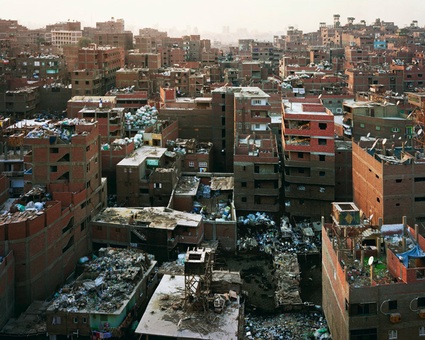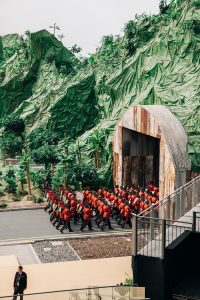Last Thursday i went to see Open City: Designing Coexistence, the main exhibition of the International Architecture Biennale Rotterdam (IABR) at the Netherlands Architecture Institute. It’s one of the most exciting and satisfying exhibition i’ve seen this year. Proper report will follow in an hopefully not too distant future. Until then here’s one of the striking images by photographer Bas Princen i discovered in the exhibition:
 Bas Princen, Mokattam Ridge (Garbage city), Cairo 2009
Bas Princen, Mokattam Ridge (Garbage city), Cairo 2009
I first thought tPrincen‘s photograph was fake. How could this be real?
Looking online for the location of the photo, Mokattam, i discovered that the image is authentic. It’s a hilly suburb of Cairo called Garbage City. The Zabbaleen, a community of mainly Coptic Christians, live there. Since the ’50s, they have been making a living by collecting, sorting and disposing of Cairo’s waste.
The Zabbaleen generally perform this service very cheaply. Waste food is fed to livestock, mainly pigs; what cannot be repaired or reused -steel, glass, textile and plastic bottles- is sorted by hand and sold as raw materials; some material is burnt as fuel. It is claimed that Zabbaleen reuse or recycle 80-90% of the waste they collect (a figure that the most modern waste management systems can only dream of), however this must be put into context of the fact that the Zabbaleen concentrate on wealthier areas.
In 2003, waste management was privatized. Foreign multinational companies won rights to collect garbage in Cairo, cutting the Zebbaleen out of the trash business. Ironically, due to a government financial restrictions, the firms ended up outsourcing to the Zebbaleen. But for much less than they had made before.
Earlier this year, the Egyptian government responded to the threat of swine flu with a massive program to get rid of the pigs living in Garbage City. This appears to have been a bad idea. Still, this doesn’t prevent the slum to be a popular touristic destination.
More images of Garbage City: Light Stalkers and Market place.







